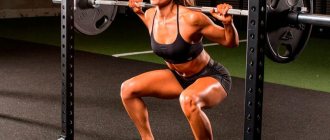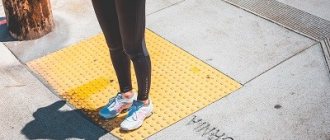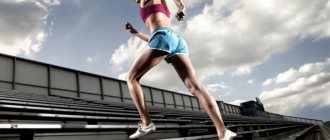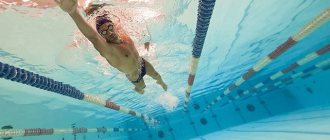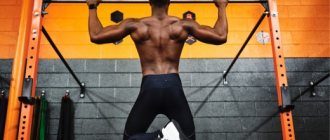Testosterone production when doing squats
The legs are the LARGEST muscle group in our body.
Performing leg exercises requires a huge amount of effort, energy and recovery capacity.
Leg training is always a HUGE STRESS for the body. After all, almost the entire body is involved in this process.
The muscles of the legs (of course), core, back, arms, etc. become tense.
Blood circulation in the lower part of the body increases, which leads to stimulation of the sex glands (in men), which then leads to the production of a huge amount of ANABOLIC HORMONES (testosterone, primarily).
Almost always, anabolic hormones are released in excess, which is enough for the restoration and growth of other parts of the body.
Especially, this is very useful for athletes who train naturally. Indeed, it is in this case (when you train without steroids and other stimulants) that the production of your OWN testosterone plays a leading role.
We must try with all our might to create a favorable anabolic background for the body to grow.
Squat technique with a barbell on the shoulders (classic squats)
This is an extremely important question, friends!
It is when performing squats with a barbell on the shoulders that the cost of error is extremely high. I can't even imagine a more dangerous exercise in bodybuilding.
Although, any exercise can become dangerous if you turn off your brain. Figuratively speaking, naturally.
Starting from ruptures of the spinal extensors, to fractures of the neck, knee joints and death (!). All this can happen if a person “put” on technique from the very beginning of his training.
That is why I ALWAYS advise that the first two to three months be paid attention to the MOST IMPORTANT period in a person’s entire future training life - the period of preparation for further hypertrophy.
Without this, everything can, sooner or later, end very badly.
There is still a chance of injury, it still remains, but you significantly reduce the risk if you perform the exercises with perfect technique.
So, how to do squats correctly:
- We approach the squat rack (as a rule, there are limiters there, install them, they give additional confidence).
- We grab the bar slightly wider than shoulder width.
- Place the bar just above the delts and just below the trapezoid.
- Strain and straighten your back, remove the bar from the racks. Attention: While performing squats, your feet must be pressed to the floor ENTIRELY!!! There should be no calf raises!!!
- We keep our heads either straight or look up. This will allow us to keep our back straight at every point of the amplitude!
- We place our feet slightly wider than our shoulders, with our toes pointing forward (you can turn them outward by 15-20 degrees).
- The back is straight, the head looks straight or up, we begin to bend the legs.
- We squat either until our thighs are parallel to the floor, or slightly lower.
- WE FEEL THE CONTRACTION AND TENSION OF OUR QUADRICEPS, we begin to move upward.
- We strain our quadriceps, straight back, look up or straight, stand up, constantly thinking about how the quadriceps feel. You must feel them AT EVERY POINT OF AMPLITUDE, otherwise, otherwise, the load may not hit the target exactly, but will “spread” over the back, buttocks and other muscles.
The simplest manipulations with squats:
- BREAK YOUR LEGS WIDER = the inner thighs work harder.
- BRINGING THE LEGS ALREADY = the lateral (outer) heads of the quadriceps are more involved in the work.
- LEANING A LITTLE STRONGER FORWARD = emphasis shifts to the gluteal muscles.
- KEEP YOUR BACK EVEN = the load falls on the quadriceps.
- TURN YOUR FEET OUTSIDE = shift the load to the lateral heads of the quadriceps.
- FEET STRAIGHT = load is distributed evenly across all heads of the quadriceps (lateral, medial, rectus and intermediate).
Under no circumstances should you:
- Push your knees forward beyond your toes . This can lead to rupture of ligaments, menisci and other unpleasant consequences.
- Bend your back at any point of the amplitude . If this trick is performed with a large enough weight, then you will have to say goodbye to barbell squats forever, and to normal training too. Can lead to rupture of spinal extensors, vertebral injuries, etc.
- Lean back too much . This will lead to a simple loss of balance and, most likely, injury.
These are the most classic squats, with which you can grow very impressive leg muscles.
A set of exercises for the hips and buttocks
The main task is to gradually increase the number of approaches and repetitions. If now, for example, you do 3 sets of 5 repetitions with a working weight of 165 kg, then by the end of the month you should perform 3 sets of 10 repetitions with the same weight (if at the beginning of the month the total number of repetitions was 15, then by by the end it will double and be 30). Muscle mass will also gradually increase.
You will be introduced to new exercise techniques: supine pelvic and leg raises, one-legged pelvic and leg raises, American deadlifts, planks, glute bridges, and reverse hyperextensions. During training, it is necessary to concentrate each time on exactly those muscles to which we apply the load.
Week #1
| 1st training | Monday | Thursday |
| 1 Lifting the pelvis and legs while lying down with weight | 3x5 | 3x6 |
| 2 Knee squats | 3x10 | 3x10 |
| 3 Leg abduction in a standing position using an elastic band | 3x10 | 3x10 |
| 2nd training | Tuesday | Friday |
| 1 Raising the pelvis and legs while lying on one leg | 2x8 | 2x8 |
| 2 American deadlift | 2x20 | 2x20 |
| 3 Plank | 3x20 sec. | 3x20 sec. |
| 3rd training | Wednesday | Saturday |
| 1 Gluteal bridge (legs on a bench) | 2x20 | 2x20 |
| 2 Squats with a dumbbell | 3x10 | 3x10 |
| 3 Reverse hyperextension | 2x20 | 2x20 |
Week #2
| 1st training | Monday | Thursday |
| 1 Lifting the pelvis and legs while lying down with weight | 3x6 | 3x7 |
| 2 Knee squats | 3x10 | 3x10 |
| 3 Leg abduction in a standing position using an elastic band | 3x10 | 3x10 |
| 2nd training | Tuesday | Friday |
| 1 Raising the pelvis and legs while lying on one leg | 3x8 | 3x8 |
| 2 American deadlift | 2x20 | 2x20 |
| 3 Plank | 3x20 sec. | 3x20 sec. |
| 3rd training | Wednesday | Saturday |
| 1 Gluteal bridge (legs on a bench) | 3x20 | 3x20 |
| 2 Squats with a dumbbell | 3x10 | 3x10 |
| 3 Reverse hyperextension | 3x20 | 3x20 |
Week #3
| 1st training | Monday | Thursday |
| 1 Lifting the pelvis and legs while lying down with weight | 3x7 | 3x8 |
| 2 Knee squats | 3x10 | 3x10 |
| 3 Leg abduction in a standing position using an elastic band | 3x10 | 3x10 |
| 2nd training | Tuesday | Friday |
| 1 Raising the pelvis and legs while lying on one leg | 4x8 | 4x8 |
| 2 American deadlift | 2x20 | 2x20 |
| 3 Plank | 3x20 sec. | 3x20 sec. |
| 3rd training | Wednesday | Saturday |
| 1 Gluteal bridge (legs on a bench) | 3x20 | 3x20 |
| 2 Squats with a dumbbell | 3x10 | 3x10 |
| 3 Reverse hyperextension | 3x25 | 3x25 |
Week #4
| 1st training | Monday | Thursday |
| 1 Lifting the pelvis and legs while lying down with weight | 3x8 | 3x9 |
| 2 Knee squats | 3x10 | 3x10 |
| 3 Leg abduction in a standing position using an elastic band | 3x10 | 3x10 |
| 2nd training | Tuesday | Friday |
| 1 Raising the pelvis and legs while lying on one leg | 3x10 | 3x10 |
| 2 American deadlift | 2x20 | 2x20 |
| 3 Plank | 3x20 sec. | 3x20 sec. |
| 3rd training | Wednesday | Saturday |
| 1 Gluteal bridge (legs on a bench) | 3x20 | 3x20 |
| 2 Squats with a dumbbell | 3x10 | 3x10 |
| 3 Reverse hyperextension | 3x30 | 3x30 |
On day 30, do lying hip and leg raises with 3 x 10 weights.
How to do leg abduction in a standing position using an elastic band - video:
American deadlift technique - video:
Technique of squats with a barbell from the knees - video:
Powerlifting barbell squats (sumo squats)
They are not much different from regular squats, but they are the BEST EXERCISE for increasing the mass of the gluteal muscles (for girls, this is generally the best exercise, in principle).
In another way, this type of squats is called: sumo squats.
Indeed, if you look from the outside, the body position is very similar to how sumo wrestlers begin their fights, the only difference being that during such squats our hands are not on our hips, but on the bar.
This is an excellent type of squat that minimizes the risk to the knee joints (since the legs are placed wider, and part of the load is shifted to the buttocks, and to another large muscle group - the back).
Because As the load is partially shifted to your back, the requirements for stability of your back, and in particular your lower back, increase. Be sure to add hyperextension (as if you are pumping your abs in reverse) to your workouts to strengthen your lumbar region.
Sumo squat technique
- We approach the squat rack (as a rule, there are limiters there, install them, they give additional confidence).
- We grab the bar with a fairly narrow grip (thumbs slightly wider than shoulders).
- We place the bar ON YOUR BACK, usually 80-120 millimeters lower than with regular squats.
- Strain and straighten your back, remove the bar from the racks. Attention: While performing squats, your feet must be pressed to the floor ENTIRELY!!! There should be no calf raises!!!
- We keep our heads either straight or look up. This will allow us to keep our back straight at every point of the amplitude!
- We place our feet 100-150 millimeters wider than our shoulders. The toes point outward at 45 degrees (i.e., figuratively, our feet should form a right angle).
- The back is straight, the head looks straight or up, we begin to bend the legs.
- We move the pelvis down and BACK, while simultaneously bending the legs at the knees (the knees do not go beyond the toes). We tilt the body slightly forward.
- We squat either until our thighs are parallel to the floor, or slightly lower.
- The body at the lowest point is tilted approximately 45 degrees, the back is PERFECTLY FLIGHT, the pelvis is laid back.
- THE LOAD SHOULD RESIST ON THE HEELS OF THE FEET, not on the toes.
- WE FEEL THE CONTRACTION AND TENSION OF OUR QUADRICEPS, we begin to move upward.
- We strain our quadriceps, straight back, look up or straight, stand up, constantly thinking about how the quadriceps feel. You must feel them AT EVERY POINT OF AMPLITUDE, otherwise, otherwise, the load may not hit the target exactly, but will “spread” over the back, buttocks and other muscles.
For those who are asking how to quickly pump up your buttocks by doing just one exercise, here is your answer - DO SUMO STYLE SQUATS.
What are the benefits of squats?
This exercise uses a large number of muscle groups, improving physical fitness and strengthening the cardiovascular system. By doing squats, you can not only achieve beautiful shapes of the gluteal muscle, but also strengthen your back and abdominal muscles. Exercise provides pressure in the chest, which improves the respiratory system, saturating the body with more oxygen.
Is it possible to pump up your buttocks with squats?
Considering that the buttocks are involved in straightening the torso, squats are one of the best methods to pump up your butt well. And the lower the squats, the better the gluteal muscles work and the more effective the exercise is for elastic buttocks.
Important to remember! In order to make your buttocks strong, you need to lift weights. To do this, you need to perform an exercise to grow muscle mass, from 8 to 12 repetitions in one approach. Between approaches you need a rest of 1 - 2 minutes. The weight of the load should be heavy enough so that you do not have enough strength to perform more than 12 repetitions, this is the effectiveness of the exercise. But it’s better to start mastering the technique with light weights, gradually adding load each workout.
Partial squats (partial squats)
This type of squats has several significant positive aspects.
When performing partial squats, the load on the back and knee joints is reduced (since the angle between the hips and calves is greater).
I also saw how powerlifters used this type of squats to break through their so-called. "psycho-emotional ceiling" That moment when you are afraid to take on new weight, because... you think you can't stand it.
These squats, in such cases, come in handy.
It is best to perform them either in a Smith machine (in a power rack).
Or in regular squat racks, but with high-mounted stops that will serve as support. If something goes wrong.
Partial squat technique
It’s no different from regular squats, the only difference being that you squat not to parallel, but a little higher.
Partial squats can be performed either classic style (a little more dangerous) or sumo style (less dangerous).
Proper nutrition for butt muscle growth
It all starts with proper nutrition. As mentioned earlier, in order to start the process of muscle growth, you need to adhere to a certain diet. Proper nutrition involves maintaining daily caloric intake and the ratio of proteins, fats and carbohydrates.
The optimal ratio of BZHU for weight gain is as follows::
- proteins – 20-30%;
- fat – 10-20%;
- carbohydrates – 50-60%.
Squirrels:
- poultry meat;
- beef;
- fish;
- chicken eggs;
- low-fat cottage cheese;
- beans, legumes.
Fats:
We recommend reading: TOP 8 questions about cardio training
- olive and linseed oil;
- nuts;
- seeds;
- avocado;
- red fish (trout, salmon, salmon).
Carbohydrates:
- cereals (oatmeal, buckwheat, pearl barley, brown rice);
- potato;
- durum wheat pasta;
- breakfast cereals without sugar;
- sweets (honey, dried fruits, kozinaki);
- vegetables and fruits.
| Eating fruits is allowed up to 1-2 pieces per day, as they contain a large amount of fructose. Despite the fact that it is a natural sugar, when it enters the body, it turns into glucose. If energy is not spent on time, it will be stored as fat. Moreover, fructose is more easily converted into fat than glucose |
Front Squats
Or a front squat.
It’s good because it focuses the load strictly on your quadriceps and makes it much easier to maintain balance (the main weight is in front, while moving the body back).
There is a slight downside in that you have to hold your hands in an awkward position to hold the barbell, but over time you will get used to it.
Front squat technique
- We approach the squat rack (as a rule, there are limiters there, install them, they give additional confidence).
- Bring your shoulders under the bar. We cross our arms and grab the bar.
- We place the bar just below your deltoids, almost above your biceps.
- We remove the bar and take a step back.
- We strain and straighten our back. Attention: When performing front squats, your feet must be pressed to the floor ENTIRELY!!! There should be no calf raises!!!
- We keep our heads either straight or look up. This will allow us to keep our back straight at every point of the amplitude!
- We place our feet slightly wider than our shoulders, with our toes pointing forward (you can turn them outward by 15-20 degrees).
- The back is straight, the head looks straight or up, we begin to bend the legs.
- We squat either until our thighs are parallel to the floor, or slightly lower.
- WE FEEL THE CONTRACTION AND TENSION OF OUR QUADRICEPS, we begin to move upward.
- We strain our quadriceps, straight back, look up or straight, stand up, constantly thinking about how the quadriceps feel. You must feel them AT EVERY POINT OF AMPLITUDE, otherwise, otherwise, the load may not hit the target exactly, but will “spread” over the back, buttocks and other muscles.
Smith machine squats
These squats are different in that the problem with stabilizing movements is COMPLETELY eliminated. You move along a strict trajectory dictated to you by the simulator.
This allows you to move your feet much further forward to shift the load on your gluteal muscles.
Nothing special about technology. As with most regular squats, only before starting the movement you will need to rotate the bar slightly around its axis to remove it from the hooks and begin the movement.
Before finishing the approach, you need to do the same thing, only in the opposite direction (to put the bar in place).
You can do a wide variety of exercises at Smith.
The most concentrated and one of the best exercises for the gluteal muscles is the following exercise.
Is it possible to pump up your buttocks with squats?
In order to become the owner of a perfect butt, it will take a lot of effort and patience. The main question that arises is how to squat correctly to pump up your buttocks?
It will not be possible to achieve an increase in volume with regular squats. Exercises without the use of weights can only strengthen and increase the tone of the target area.
You can pump up your butt only with the help of strength training. It is most productive to exercise in a gym, but with proper organization, the results will be visible during home workouts.


